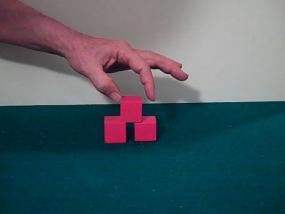The Language of Blocks, Part I - Stack, Row, Arch

When children intentionally create block structures they are, in effect, making a statement about the spatial relations among the blocks. On top, next to, between, covering are some of the relations that block structures can represent. We might want to give the structures names like arch, row, or stack; but we can understand the stages of block building better if we think about the relations that one block holds toward another. Near-but- not-touching (a gap) is more complicated than touching (a row). We can reason that the near-but-not-touching has more complexity than touching, the same way an aborted kiss is an action on an action and a kiss is simply that action executed.
Part I of The Language of Blocks covers the most elementary structures, the stack, the row, and the arch. Listen to the narrator (George Forman) as he explains how children “speak” spatial relations with blocks and also how children “read” a lone block on the table in different ways, sometimes as “coming up from the table,” sometimes as “the beginning of a horizontal extension.” These different “readings” of the lone block cause the child to complete the “sentence” with different endings, to wit, a stack, a row or an arch.
Download consists of a high resolution 4 minute 48 second Quicktime video file and a text file with the above introduction in a zipped folder.
